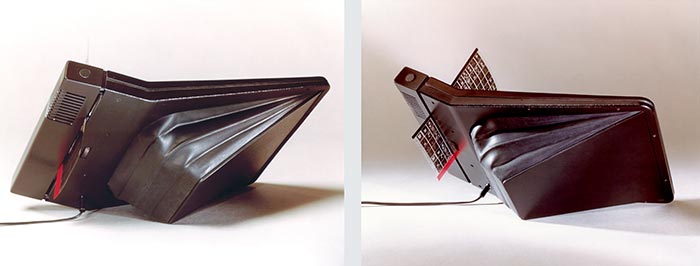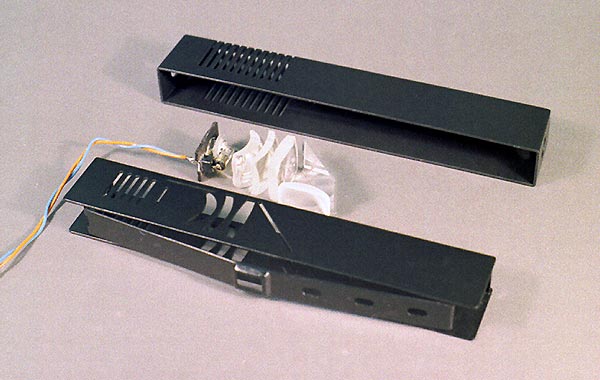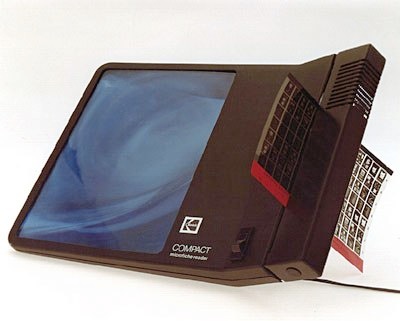Kodak Compact Microfiche Reader
Kodak Compact Microfiche Reader
The Kodak Compact Microfiche Reader concept was developed by Steve Hines in 1974, at the Kodak Research Laboratories and is the subject of Steve’s first utility patent.

The Compact Microfiche Reader wins in size and weight with four or more microfiche, compared to carrying hard copy. Conventional microfiche readers at the time were 110V desk-top units approximately the size and weight of a television of the same screen size.
This microfiche reader is not a rear-projection device as it may appear. The image is front projected on an internal flat screen from an angle which causes the image to be keystoned. When the screen is hinged open, and viewed through the clear Fresnel lens, the narrow side of the screen is magnified more, than at the hinge, to create a rectangular appearing image.

The mockup to determine the screen angle to give the keystone-shaped screen the appearance of being rectangular when viewed through the Fresnel lens.
The Fresnel Lens (pronounced: Fra-‘nel):
• magnifies the narrow side of the keystoned image to make the image look rectangular,
• acts as a field lens to brighten the corners,
• skews the optical axis to center the hot spot with the Fresnel lens,
• adds a slight tint to increase image contrast,
• uses a slight blue tint to compensates for the warm color of the projection lamp which is under-volted to increase lamp life.

The underside of the front face. Interior views of the screen and back panel, flat, and open.
The bi-stable latch:

The internal strut has an oil-can action that makes it snap open, or collapse when pressed closed.

| The bi-stable strut that supports the projection screen is opened by pulling the bellows. A living hinge in the strut is molded in a slight dome to snap open. When the hinge is pressed through the rubber, the hinge buckles to fold flat. |
When closed, the keystoned projection screen can be seen, flat against the inside of the clear Fresnel lens. As the screen is opened, the right side of the screen is magnified by the Fresnel lens, to look rectangular. |
The Optical Condenser:

The optical condenser in the handle, shows the lamp, lenses and 45° mirror in exploded view. The film gate is centered on the springy pressure plate. The three oval holes allow escaping air, from inside the reader, to vent through the condenser to cool the lamp when being closed.
Folding and carrying:
|
||
| The Compact Reader is approximately the size of a sheet of typing paper, and folds to one inch thickness, making it easy to carry. |
Compact Microfiche Reader Features:
• Folding, front-projection microfiche viewer.
• Space saving, compared to carrying printed material.
• Optical magnification: 24X .
• Screen size: 10-inch diagonal.
• Maximum thickness when closed: 1 inch.
• Weight: 11 oz. (prototype)
• Lamp-housing cover removes easily for lamp replacement.
• The air in the bellows cools the lamp when closing.
• Low voltage, safe operation.
• Power: 12V DC, from external AC adapter or battery.
Comments:
• “Congratulations on your reader… Very clever device.” Don Iwerks, Aug. 5, 2020,
• “What a sweet piece of design and engineering!”, Andy Baird, Aug. 2, 2020
• “Your compact microfiche reader is one of the coolest things I’ve ever seen.” Nick Hardman, Sept. 4, 2019
For further information, see:
U.S Patent 4,157,214 contains information on the front-projection version (shown), and also on a rear-projection version.
This is not a product for sale, but is shown as an example of technology, developed by Steve Hines, who now offers consulting. Please contact Steve at:
USA
email: Steve@HinesLab.com
ph. 818-507-5812



